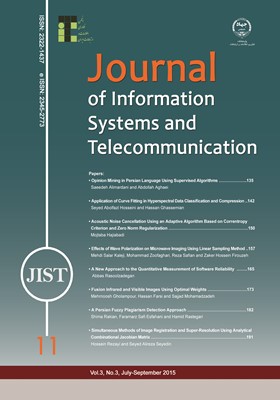-
-
List of Articles
-
Open Access Article
1 - Opinion Mining in Persian Language Using Supervised Algorithms
Saeedeh Alimardani abdollah aghaei -
Open Access Article
2 - Application of Curve Fitting in Hyperspectral Data Classification and Compression
S. Abolfazl Hosseini -
Open Access Article
3 - Acoustic Noise Cancellation Using an Adaptive Algorithm Based on Correntropy Criterion and Zero Norm Regularization
Mojtaba Hajiabadi -
Open Access Article
4 - Effects of Wave Polarization on Microwave Imaging Using Linear Sampling Method
Mehdi Salar Kaleji Mohammad Zoofaghari reza Safian Zaker Hossein Firouzeh -
Open Access Article
5 - A New Approach to the Quantitative Measurement of Software Reliability
Abbas Rasoolzadegan -
Open Access Article
6 - Fusion Infrared and Visible Images Using Optimal Weights
Mehrnoush Gholampour Hassan Farsi Sajad Mohammadzadeh -
Open Access Article
7 - A Persian Fuzzy Plagiarism Detection Approach
Shima Rakian Faramarz Safi Esfahani Hamid Rastegari -
Open Access Article
8 - Simultaneous Methods of Image Registration and Super-Resolution Using Analytical Combinational Jacobian Matrix
Hossein Rezayi Seyed Alireza Seyedin
-
The rights to this website are owned by the Raimag Press Management System.
Copyright © 2017-2025







